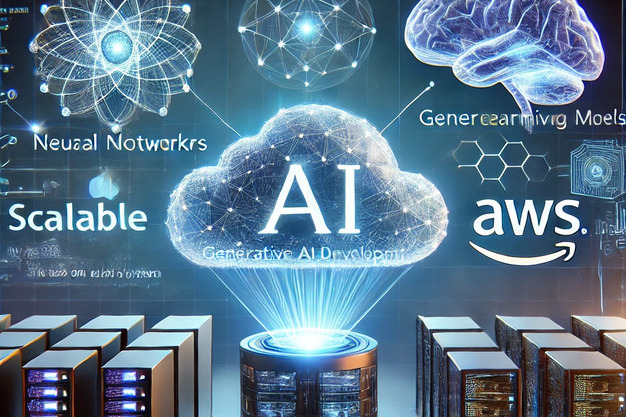How Do You Build Generative AI Applications on AWS?
AWS provides a suite of AI/ML services, making it easier to develop and deploy generative AI applications. Learn everything you need to know here.
Generative AI landscape in 2024
Generative AI has seen major evolutions – from initial hype to widespread strategic adoption driven by recent LLM innovations and multimodal models that enhance enterprise value.
Multimodal and custom FMs
Multi-modal generative AI models are gaining traction for their ability to ingest diverse inputs and generate corresponding outputs spanning text, images, code, and more.
For example, GPT-4 Vision (GPT-4V) is an extension of GPT-4 that includes multimodal capabilities, allowing the model to process and understand text and images concurrently.
Role of cloud services in building GenAI apps
Generative AI models require large datasets to train and improve output. For example:
- BERT is trained with 3.3 billion tokens and 340 million parameters.
- GPT-3 has a 96-layer neural network and 175 billion parameters.
Training AI models with more than 170 billion parameters requires extensive resources – high computing power, CPUs, and GPUs. Cloud computing services offer scalable infrastructure for this purpose.
Why AWS is the best cloud platform for generative AI development
AWS offers a range of generative AI applications that you can customize based on specific data, use cases, and customers.
Key benefits of using AWS for GenAI application development:
- Easiest place to build: Secure, customizable Feature Models, easy model customization with Amazon Bedrock.
- Most price-performant infrastructure: Designed for high-performance machine learning.
- Enterprise-grade security and privacy: Pre-built services like IAM, KMS, and WAF.
- Fast experimentation: SageMaker Notebook allows quick prototyping.
- Pre-trained models: Amazon Kendra and Polly offer high-quality pre-trained models.
- Integration with AWS services: Easily integrates with AWS databases and analytics.
- Responsible AI: Built with responsible AI principles.
How to develop a generative AI app on AWS: A step-by-step process
The generative AI development process requires:
- Foundation model interface – Provides access to the generative AI models through an API
- Front-end web/mobile application – The user-facing part of the application that runs on websites or mobile devices
- Data processing labeling – Preparing and annotating data to train models
- Model training – Using labeled data to teach model patterns and improve performance
- High-quality monitoring and security tools – Overseeing models, detecting issues, and protecting data and systems
- Vector database – Storage for vector representations of text and images used by models
- Machine learning platform – Infrastructure for developing, testing, deploying, and managing models
- Machine learning network storage – Data storage is networked for efficient ML tasks
- AI model training resource – Computing power like GPUs for model training
- Text-embeddings for vector representation – Representing text as vectors in numerical form for models
Now that you know the prerequisites, it is time to understand the steps required to develop a generative AI application with AWS.
Step 1: Choose your approach
There are two popular approaches to building generative AI applications. One is to create the algorithm from scratch. Another is to use a pre-trained model and fine-tune it for your specific project.
Approach 1: Create an AI model from scratch
AWS offers Amazon SageMaker, a managed service that simplifies the deployment of generative AI models. It provides tools for building, training, and deploying machine learning models, including the ability to create generative AI models from scratch.
Approach 2: Fine-tune existing FMs
If you want to use an existing FM and fine-tune it for your generative AI application, Amazon Bedrock is the best option. It allows you to fine-tune FMs for specific tasks without the need for annotation of BigData.
Once you choose the approach you want to use for creating a generative AI application, the next step is to plan for data that will help train the algorithms.
Step 2: Prepare your data
Preparing the data for model training involves collection, cleansing, analysis, and processing.
Here is how you can prepare data for generative AI development on AWS:
#1. Data collection
Gather a large, relevant dataset representing the desired model output. For example, to train a model to detect pneumonia from lung images, collect diverse training images of both healthy lungs and lungs with pneumonia.
So, based on the use case, you need to identify the sources and types of data to collect. Tools like Amazon Macie can help classify, label, and secure the training data.
#2. Data preprocessing
Clean and format the raw data to prepare it for modeling. This includes removing noise/errors, handling missing values, encoding categorical variables, and scaling/normalizing numeric variables.
You can use Amazon EMR with Apache Spark and Apache Hadoop to process and analyze large amounts of information.
#3. Exploratory data analysis
Understand the data distribution, identify outliers/anomalies, check for imbalances, and determine appropriate preprocessing steps. You can streamline data analytics by building an ML pipeline with Amazon SageMaker Data Wrangler.
#4. Feature engineering
Derive new input features or transform existing ones to make the data more meaningful/helpful in learning complex patterns. For image/text data, this involves extracting relevant features. You can use Amazon SageMaker Data Wrangler to simplify the feature engineering process, leveraging a centralized visual interface.
Amazon SageMaker Data Wrangler contains over 300 built-in data transformations that help you normalize, transform, and combine features without coding.
#5. Train split
Randomly divide the preprocessed data into training and test sets for building/evaluating the model.
- Model training: Feed the training set into the generative model and iteratively update its parameters until it learns the underlying patterns in the data. You can use AWS Step Functions Data Science SDK for Amazon SageMaker to automate the training of a machine learning model.
- Evaluation: Use offline or online evaluation to determine the performance and success metrics. Verify the correctness of holdout data annotations. Fine-tune the data or algorithm based on the evaluation results and apply data cleansing, preparation, and feature engineering.
Step 3: Select your tools and services
There are five main AWS services to consider for generative AI app development:
Amazon Bedrock
Amazon Bedrock is a fully managed service that provides cutting-edge foundational models (FMs) for language and text tasks, including multilingual and text-to-image capabilities. It helps you fine-tune foundation models from AI companies like AI21 Labs, Anthropic, Stability AI, and Amazon, which are accessible through integration with custom APIs.
If you decide to choose Amazon Bedrock, here are some tips for choosing the right FM:
- Clearly define the specific task or problem you want your generative AI model to solve.
- Assess the capabilities of different foundation models and determine which ones suit your use case.
- Consider the trade-off between model size and performance based on your specific needs.
- Look for foundation models that have been evaluated and benchmarked for performance on relevant tasks.
- Evaluate the training data used for each model and consider whether it aligns with your specific domain or industry.
- Consider the level of support provided for each foundation model, including documentation, community support, and availability of updates.
AWS Inferentia and AWS Trainium
AWS Inferentia and AWS Trainium are custom machine learning accelerators designed by AWS to improve performance and reduce costs for machine learning workloads.
AWS Inferentia is optimized for cost-effective, high-performance inferencing. It allows you to deploy machine learning models that provide quick, accurate predictions at low cost. Inferentia is well-suited for production deployments of models.
AWS Trainium is purpose-built for efficient training of machine learning models. It is designed to speed up the time it takes to train models with billions of parameters, like large language models. Trainium enables faster innovation in AI by reducing training costs.
Amazon Code Whisperer
Amazon CodeWhisperer, an AI coding companion, is trained on billions of lines of Amazon and open-source code. It helps developers write secure code faster by generating suggestions, including whole lines or functions, within their IDE. CodeWhisperer uses natural language comments and surrounding code for real-time, relevant suggestions.
Amazon SageMaker
Amazon SageMaker provides a great solution to maintain complete control over infrastructure and the deployment of foundation models. SageMaker JumpStart is the machine learning hub of Amazon SageMaker that assists customers in discovering built-in content to develop their next machine learning models. The SageMaker JumpStart content library includes hundreds of built-in content algorithms, pretrained models, and solution templates.
Step 4: Train or fine-tune your model
The next step is to either train your model or fine-tune it. Data quality is crucial in both scenarios, so you must ensure comprehensive data collection and analysis. Now, if you are using a foundation model and trying to fine-tune it for your business, there are three types of fine-tuning methods that you can use.
1. Instruction-based fine-tuning
Customizing the FM with instruction-based fine-tuning involves training the AI model to complete specific tasks based on task-specific data labels. This customization approach benefits startups looking to create custom FMs with limited datasets.
2. Domain adaptation
Using the domain adaptation approach, you can train the foundation model with a large domain-specific dataset. If you build a generative AI application based on proprietary data, you can use the domain adaptation approach to customize the FMs. For example, healthcare startups and IVF labs can leverage the domain adaptation approach.
3. Retrieval-Augmented Generation(RAG)
RAG is an approach where FMs are augmented with an information retrieval system based on highly dense vector representations. Text embedding of proprietary data enables the generation of a vector representation of a large amount of data. The context of the prompt is based on what a user enquires about and defines what a prompt represents.
However, if you want to build an AI model from scratch, you can use Amazon SageMaker to train the model. Here is a brief overview of the process:
- Prepare the data: Use your Amazon SageMaker Notebook to preprocess the data you need to train.
- Create a training job: In the SageMaker console, create a training job that includes the URL of the Amazon S3 bucket where you’ve stored the training data, the compute resources for model training, and the URL of the S3 bucket where you want to store the output of the job.
- Train the model: Once the training job is set up, you can train the machine learning model using SageMaker’s built-in algorithms or by bringing your training script with a model built with popular machine learning frameworks.
- Evaluate model performance: After training, evaluate your machine learning model’s performance to ensure the target accuracy for your application.
Step 5: Build your application
You can leverage various AWS services to deploy your trained generative AI model into a complete application.
First, package and serialize your model and any dependencies and upload it to an S3 bucket. This allows for durable storage and easy model versioning.
Next, create a Lambda function that downloads the model file from S3, loads it into memory, preprocesses inputs, runs inferences, and returns output. Configure appropriate timeouts, memory allocation, concurrency limits, logging, and monitoring to ensure scalable and reliable performance.
Expose the Lambda function through API Gateway, which provides a scalable proxy and request-handling logic. Secure access to your API using IAM roles, usage plans, API keys, etc.
You have multiple hosting options for the client-facing UI – a static web app deployed on S3, CloudFront, and Amplify, or a dynamic one on EC2, Elastic Beanstalk, etc. Integrate UI requests with the backend API.
Alternatively, for containerized apps, deploy on ECS or AWS Fargate. For GraphQL APIs, use AWS AppSync with built-in filtering, caching, and data management capabilities.
Step 6: Test and deploy your application
Conducting thorough testing is crucial before deploying your application on AWS for production. This includes testing for functionality through the unit, integration, and end-to-end tests. Further evaluating performance under load, stress, and scalability scenarios is also crucial for your generative AI applications.
Analyze potential biases in the data, model fairness, and outcome impacts to ensure ethical AI deployment. This includes vulnerability scanning, penetration testing, and compliance checks for enhanced data security.
Once testing is complete, deploy the application on AWS using infrastructure as code, automated deployment, A/B testing, and canary deployment. For example, you can use AWS Neuron, the SDK that helps deploy models on Inferentia accelerators, integrating with ML frameworks like PyTorch and TensorFlow.
Lastly, implement auto-scaling and fault-tolerant architectures to ensure reliability and scalability in production.





